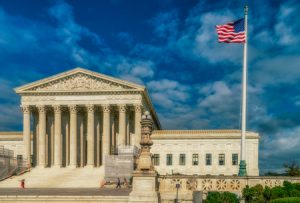U.S. Supreme Court cases about subjects such as improper employee dismissal or construction of criminal statutes don’t usually register on patent attorneys’ radar—but should they?
 Those who practice in the field of patents tend to focus almost exclusively upon developments in patent law and pay less attention to developments in other areas of law. This is to be expected; patent cases don’t usually overlap with issues such as employment law or criminal law; so why bother reading up on those subjects?
Those who practice in the field of patents tend to focus almost exclusively upon developments in patent law and pay less attention to developments in other areas of law. This is to be expected; patent cases don’t usually overlap with issues such as employment law or criminal law; so why bother reading up on those subjects?
And yet, it can actually be useful to keep abreast of Supreme Court decisions that on their faces do not pertain to patent law. A few days ago, IPWatchdog Founder and CEO Gene Quinn discussed one such case. Though that case was not patent-related, he felt the decision may be of interest to patent practitioners, especially those dealing with patent eligibility under section 101.
In that same vein, following is a discussion of a (less recent) decision from the United States Supreme Court that patent practitioners may have overlooked. On its face, the case deals with employment law, but it includes aspects of federal administrative practice that can affect patent practitioners.
Elgin v. Department of the Treasury
In Elgin v. Department of the Treasury, 567 U.S. 1 (2012), Elgin was a federal employee who challenged his dismissal from a government agency, pursuant to a federal statute. His case was heard by an administrative tribunal (not an Article III court). Part of his challenge was that the statute suffered from constitutional infirmities. The Administrative Law Judge ruled that the agency lacked authority to determine the constitutionality of the statute. Elgin then pressed his arguments in a case in Federal District Court. The federal judge ruled that an Article III court did have jurisdiction to hear the case, but that the constitutional challenges were without merit. The case wound up in the First Circuit Court of Appeals, which ruled that the constitutional challenges must be made and considered during the administrative review, not in Federal Court.
The Supreme Court agreed with the First Circuit.
It is well-settled, observed the Supreme Court, that an administrative agency lacks the authority to determine the constitutionality of a statute. 567 U.S. at 16 (citing authorities). Further, when an administrative agency concludes that it lacks authority to decide such questions, a federal court may address such questions on appeal. Id. at 18 n. 8.
But even if the agency lacks the authority to decide a constitutional issue, it may still have a constitutional question presented to it; and the administrative agency may also make an evidentiary record about the constitutional challenge. See id. at 19. The appellate court, as we all know, is not in the business of making evidentiary records. If an evidentiary record must be made, then it must be made before the agency.
Moreover, even if the administrative agency lacks the authority to decide a constitutional issue, the agency still may have the authority to take substantive action that effectively addresses the constitutional issue. The agency need not dismiss or refuse to decide a matter that raises a constitutional question. Id. at 20-21.
What it Means for Patents
The statutory scheme in Elgin is, of course, different from the statutory schemes with which patent practitioners are familiar. But the underlying rationale and observations in the Elgin case may give some patent practitioners some food for thought: if you want to challenge an action of the United States Patent and Trademark Office (USPTO) on constitutional grounds, you can and ought to raise those challenges before the agency; and you should not expect to be able to bypass the agency and go straight to court.
From time to time, the USPTO may take an action that is, in the view of the patent practitioner, unconstitutional. The action may be in violation of rule or statute as well, but there may be cases in which the agency action constitutes, for example, a violation of the Due Process or Equal Protection Clauses, or an unconstitutional taking of property without proper compensation. Maybe constitutional questions are not raised as “routinely” with the USPTO as they are with Elgin’s agency (567 U.S. at 8, 16 n. 9), but such questions do arise in the USPTO from time to time.
Some patent practitioners adhere to the view that raising constitutional questions before the USPTO in general, and before a non-lawyer examiner in particular, ought not to be done for the simple reason that it would be a complete waste of time and effort. An examiner would dismiss such arguments out-of-hand, they say, and the USPTO cannot declare its statutes unconstitutional in any event. Therefore, there is no point in asserting such issues at the agency level.
But, as indicated by Elgin, making constitutional arguments to the agency might not be a waste of time, and might even be unavoidable. Even though the USPTO cannot definitively say what the law is from a constitutional standpoint, the agency can do at least two things. One, it can make (or allow to be made) an evidentiary record related to the challenge, if such a record is needed. And two, it can sometimes effectively resolve the constitutional question by choosing to act in a constitutional fashion. Maybe a rule or agency practice does not require a hearing under certain circumstances, for example, but when presented with a Due Process challenge, the agency may decide to grant a hearing anyway. And thus, the constitutional question is made moot without ever deciding it on the merits.
There is a further benefit for making constitutional challenges before an agency, namely, to preserve the error and to avoid concerns about waiver at the appellate level. Constitutional challenges can be waived if not properly preserved. Some Article III courts may question whether a challenger ought to be able to overturn an agency action based upon a constitutional argument, when the challenger had an opportunity to make that argument to the agency (and give the agency an opportunity to act in a constitutional fashion) but chose instead to make the argument for the first time on appeal.
When in Doubt, Keep Records
Thus, if a constitutional question arises during patent prosecution, do not ignore it. Preserve the issue and make an evidentiary record if appropriate. Do not assume that the issue can only be resolved by a court and that raising it at the agency level is unnecessary. In fact, if Elgin is any indication, your case may depend on it.
In a subsequent essay, I will discuss another non-patent Supreme Court case—this one having to do with rules governing construction of criminal statutes—that patent practitioners may not have noticed, but arguably should.

![[IPWatchdog Logo]](https://ipwatchdog.com/wp-content/themes/IPWatchdog%20-%202023/assets/images/temp/logo-small@2x.png)

![[Advertisement]](https://ipwatchdog.com/wp-content/uploads/2024/04/Patent-Litigation-Masters-2024-sidebar-early-bird-ends-Apr-21-last-chance-700x500-1.jpg)

![[Advertisement]](https://ipwatchdog.com/wp-content/uploads/2021/12/WEBINAR-336-x-280-px.png)
![[Advertisement]](https://ipwatchdog.com/wp-content/uploads/2021/12/2021-Patent-Practice-on-Demand-recorded-Feb-2021-336-x-280.jpg)
![[Advertisement]](https://ipwatchdog.com/wp-content/uploads/2021/12/Ad-4-The-Invent-Patent-System™.png)







Join the Discussion
One comment so far.
Greg Aharonian
March 14, 2019 12:26 amYes, a good suggestion – raise Constitutional issues in Office Action responses. For example, every 101 rejection should include in the Response a request to the examiner to withdraw the rejection because the use of “abstract” is an APA Administrative Abuse because there is insufficient guidance from either the USPTO or caselaw as to the definition of “abstract”. Any patent lawyer willing to guarantee that the claims he or she writes WON’T be rejected under 101? No. 101 caselaw collectively violates Due Process Public Notice for its massive inconsistencies (making it impossible for the USPTO to derive any consistent guidance – GIGO). With this Response, either the examiner can then agree, and withdraw the 101 rejection, or refuse, establishing grounds to appeal into the courts. Sad to say, in the last ten years, there have been over 200,000 patent applications attacked with 101 rejections. I doubt more than a handful have used this powerful counterattack, which is a collective incompetence.